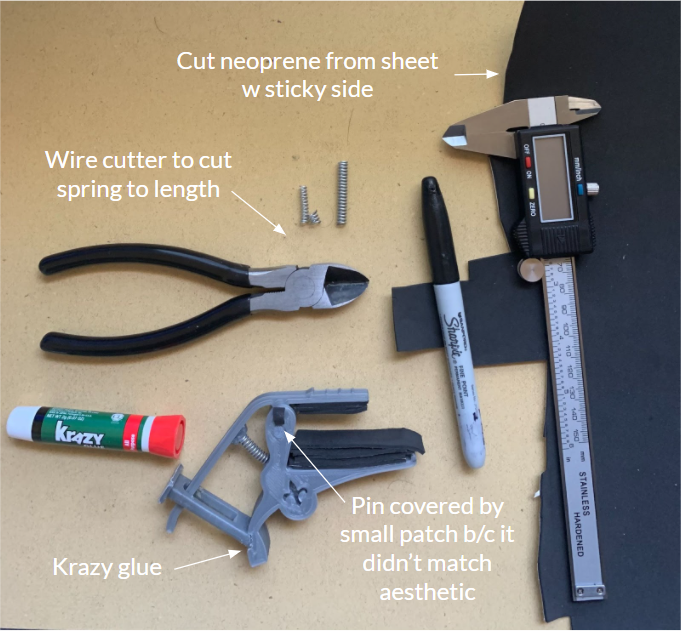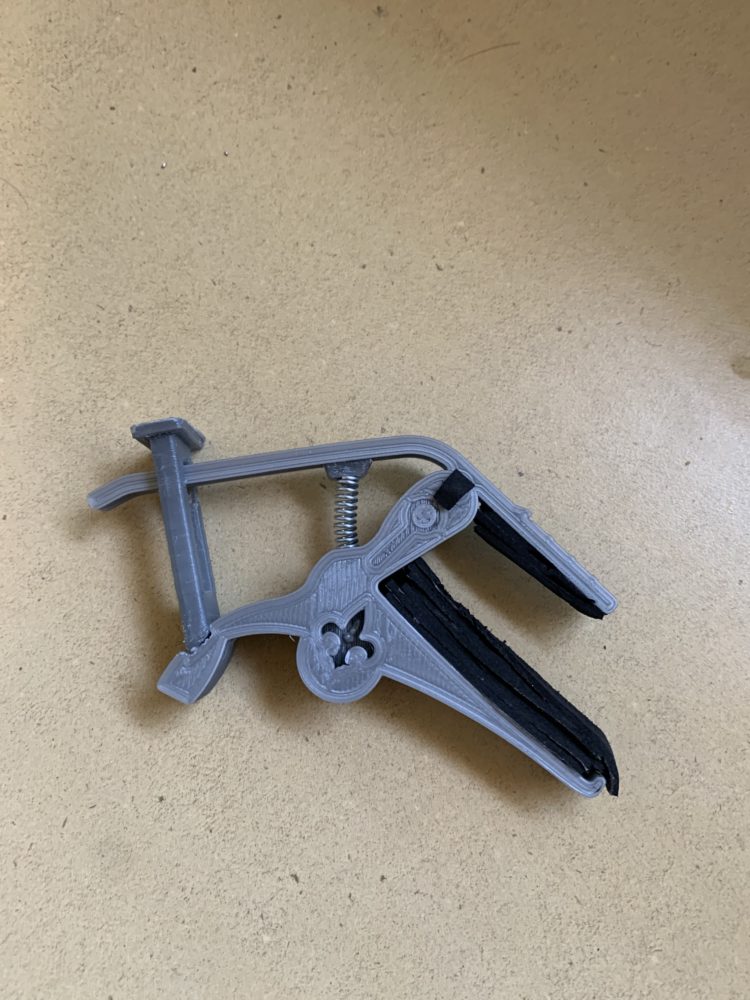For my project, I designed and 3D printed a guitar capo. A capo is a clamp made of plastic that uses a spring force to press onto the strings of a guitar and raise its tuning. I have been practicing guitar on and off for a few years, and I’ve wanted to get one for a while. This project was the perfect opportunity to build one myself, and make it unique for my instrument.

Figure 1
 Figure 2
Figure 2
When I set about designing the capo in CAD, my first priority was to make the portion of the capo that clamped onto the guitar as industry standard as possible. It is entirely possible to damage the strings, or even worse the fretboard if the dimensions of this were wrong. I did take measurements of my guitar’s actual fretboard, but I mostly based this part off of an existing capo like in Figure 1. After this, I played around with the overall aesthetic in Solidworks and made a weird, curvy design, shown in figure 2. The design kind of reminded me of the renaissance aesthetic from class, so I decided to just base my whole capo around the time period.

Figure 3
After talking with my pod, we agreed that the capo needed more of an aesthetically pleasing design. The first thing I thought of when thinking of this aesthetic is the fleur-de-lis symbol. I think it helps express that I am trying to emulate the renaissance specifically. While looking for other symbols of the period, I learned that knights were still present during the renaissance. I think knights are cool, so I added a mace symbol. I put it on a thin part of the plastic, so it isn’t as present as the fleur-de-lis. I think these symbols are a good way to give the capo more aesthetic, and they are also simple to make since I just have to add them into the 3D printed design.

Figure 4

The other way I decided to add some flavor to the capo is with a renaissance arch. The image in figure 5 was my main inspiration, specifically because I liked the flat, rectangular top. When I first designed the arch, I added small fleur-de-lis symbols in place of the eagles at the corners. However, because of the small size of my arch, it would be impossible for the 3D printer to print the level of detail I needed. I squashed the arch down, and I realized this was a blessing in disguise because it helped make the ergonomics and overall design of the capo unique.
I opted not to use a torsion spring because I thought they were way more complicated to implement then they actually are. This means I was using a normal compression spring near the pivot point of my clamp mechanism. One problem this posed was that my clamp and clamp lever were only attached at one point, the pin. Usually, this gets solved by making an ergonomic plastic shell that surrounds the two pieces and keeps them together. There was no way I was going to make that with an acceptable amount of prototyping failures, so the arch made it so I could just add a “top” contact point to extend the lever to its maximum reach. I looked online, and I can’t find a capo with this design anywhere. Probably because it isn’t the best way to restrict the lever, but I like it because it is unique.

Figure 6
The final part of my design goals was to add more functionality to the capo. Most of this attention went to the arch again because I figured this would be the hardest part to design. It had to connect to a curved handle, it had to keep the lever arm contained within it, it had to be tall enough to give the lever arm enough space to clamp down on the guitar, it had to be ergonomic so it didn’t get in the way of my hand when I used the capo, and it had to look good. I also added a mounting hole for the spring in the capo, and a piece for the spring to attach to on the lever arm. I would have to glue the piece onto the lever arm, but this wasn’t a big deal. The day that I went to print my pieces however, was a big deal.

Figure 7
April 3rd was the day I planned to build pretty much my whole project. I would spend the day with my brother and his 1.75 mm personal 3D printer, printing and reprinting the pieces so I could have a nice April. However, his 3D printer was broken, and the marble filament I bought was useless. The reason I haven’t brought up the color of the capo until now is because I was planning on using this marble filament recommended to me by my podmate, but I had to scrap that and print at the Idea Forge now. Their Lulzbot printers used 3 mm filament, so I chose a grey filament to represent stone for my capo.

Figure 8
The timeline in figure 8 has boxes around major events, and ovals around subcomponents of the events. The construction of my project mostly consisted of 3D printing the parts from the Idea Forge, loosely assembling the capo to confirm the alignment, reprinting the pieces if they didn’t fit, and then adding the spring and neoprene foam to the capo. The last step of that process was way harder than I initially thought, and also way harder than the arch. I actually only had to print the arch one time which made it the easiest component, and the foam was by far the most time consuming to get right. The reason for this was because of my spring and the way I designed my spring mount. I went through three different springs, each with stronger compression forces before I reached an acceptable amount. I also had to cut the spring to the goldilocks length for my capo. If I made it too short it would fall out of the mount, and if I made it too long it would bend and not apply enough force to press onto all six strings. While I was adding the springs, I was also adding layers of neoprene foam to the jaws of the capo. The foam that I bought was not as hard as I would have liked, so that coupled with the weak spring made it so I had to add more layers of foam to completely tune the guitar. The PLA plastic was also not as strong as the plastic used in industry capos, so this made it so I had a lot of trouble getting the capo to function properly.

Figure 9

Figure 10
After layering the foam in a slightly crossed pattern, I finally found a setup that tuned all six strings reliably, which is at the bottom of figure 10. I decided that I would just take my hands off and call it, even though the neoprene foam was not as neatly layered as I would have liked. I was taking it off and on all the time, so I didn’t put much thought into it until after it was too late. The final product did not come out exactly as I planned, but I think it did achieve a renaissance aesthetic and a unique design.

Figure 11
In conclusion, my final project did not meet my expectations in terms of the challenge of constructing it. The part I thought would be hardest was the easiest, and the part I thought would be easiest was the hardest. If I made it again, I would use harder foam and also a harder spring. I think the PLA plastic from the 3D printer is acceptable for tolerating some higher forces because it was fine while I was clamping it on and off the guitar. I also would look at using a torsion spring design so that the gate and the bottom part of the capo can be more effectively utilized for aesthetic purposes. In the future, I plan on adding more color to the capo, because having it all be grey is a little boring. When my brother’s printer is back up and running, I will use my marble filament to reprint some of the pieces. I am also thinking about buying a white filament, so the clamp can be a clean white, the arch can be a textured marble, and the lever of the clamp can contrast those by staying grey. Even though the capo did not fully meet my expectations, I am still really proud of it especially compared to my upcycle project. I think it is a good way of tracking my aesthetic progress over the semester, and I am excited to use it to play Smoke On The Water on guitar.

Figure 12
Video Presentation Link: Link
![]()

2 Comments. Leave new
Hey Bryce, this is a sweet idea! I particularly like the archway you included in the design, I think it really helps along with the fleur-de-lis symbol. Initially I was curious about your ability to get enough tension but it seems like you figured it out! Nice job on this! I would be cool to see a video of it in action.
Bryce, I think this was a really cool, ambitious project to pursue this semester, and it came out really well! I like the idea of the Renaissance aesthetic, and I think you pulled it off quite well considering the small amount of space you had to work with. I am also glad that the 3D printer had enough resolution to print out some of the details you wanted, as I know this was an issue early on in the process. You mentioned that in the future you may consider pursuing a torsion spring design; I was wondering if you have looked into this at all yet, and if you think in hindsight this would have been a better choice for your project? Overall, you did a fantastic job, and I am glad that you are happy with it!